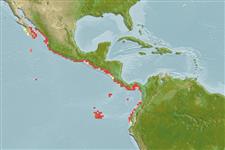Environment: milieu / climate zone / depth range / distribution range
Ecologie
marien rifbewoner. Tropical; 26°N - 3°S, 113°W - 76°W (Ref. 114953)
Eastern Central Pacfic: Baja California (Mexico) to Ecuador; including the Galapagos Is.
Lengte bij maturiteit / Grootte / Gewicht / Leeftijd
Maturity: Lm 110.0 range ? - ? cm
Max length : 260 cm TL mannelijk / geslacht onbekend; (Ref. 9254)
Inhabit rocky and coral reefs (Ref. 12951); on soft and sandy bottoms. Feeds mainly on mantis shrimps and fishes (Ref. 114953). Ovoviviparous (Ref. 50449). Litters of 1-5 pups; gestation period 10-11 months (Ref. 114953); Caught rarely by the gillnet fisheries operating in shelf waters. Utilized for its meat (Ref.58048).
Exhibit ovoviparity (aplacental viviparity), with embryos feeding initially on yolk, then receiving additional nourishment from the mother by indirect absorption of uterine fluid enriched with mucus, fat or protein through specialised structures (Ref. 50449). Distinct pairing with embrace (Ref. 205). Brood consists of 1-3 neonates and grow to about 40 cm DW in spring-summer (Ref. 38396).
Compagno, L.J.V., 1999. Checklist of living elasmobranchs. p. 471-498. In W.C. Hamlett (ed.) Sharks, skates, and rays: the biology of elasmobranch fishes. Johns Hopkins University Press, Maryland. (Ref. 35766)
Status op de Rode Lijst van het IUCN (Ref. 130435)
Gebruik door de mens
Visserij: van minder commercieel belang
Tools
Speciale rapporten
Download XML
Internetbronnen
Estimates based on models
Preferred temperature (Ref.
123201): 23.1 - 28.5, mean 27 °C (based on 40 cells).
Fylogenetische diversiteitsindex (Ref.
82804): PD
50 = 0.5039 [Uniqueness, from 0.5 = low to 2.0 = high].
Bayesian length-weight: a=0.00646 (0.00265 - 0.01571), b=3.06 (2.86 - 3.26), in cm total length, based on LWR estimates for this (Sub)family-body shape (Ref.
93245).
Trofisch niveau (Ref.
69278): 3.5 ±0.37 se; based on food items.
Weerstandsvermogen (Ref.
120179): Zeer laag, minimale populatieverdubbelingstijd meer dan 14 jaar (Fec=1-3).
Fishing Vulnerability (Ref.
59153): Very high vulnerability (90 of 100).
Nutrients (Ref.
124155): Calcium = 4.25 [0.50, 62.97] mg/100g; Iron = 0.352 [0.028, 3.714] mg/100g; Protein = 22.4 [20.0, 24.7] %; Omega3 = 0.0681 [, ] g/100g; Selenium = 41.8 [8.1, 218.8] μg/100g; VitaminA = 14.9 [1.2, 155.3] μg/100g; Zinc = 0.592 [0.036, 6.796] mg/100g (wet weight);
